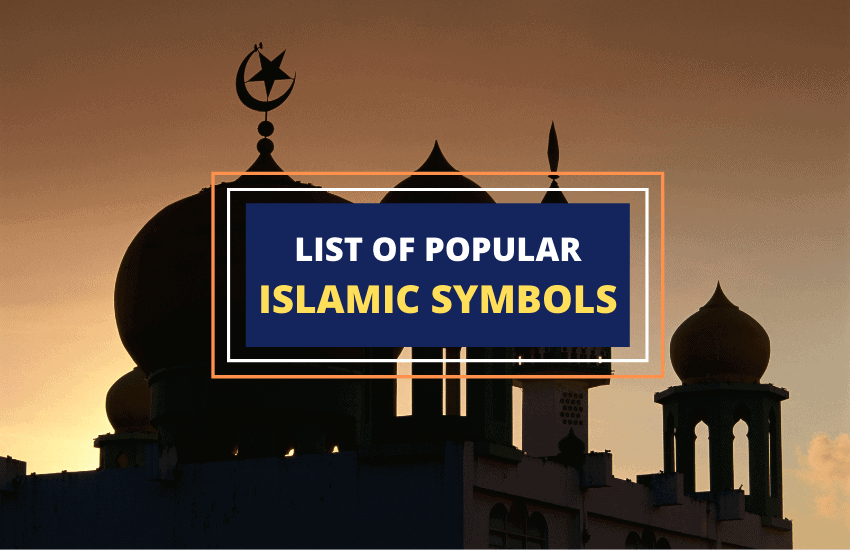
Table of Contents
Islam is currently the second most popular religion in the world with nearly 2 billion followers all over the globe. With a rich history and cultural heritage spanning a millennium and a half, you’d think that there are thousands of fascinating Islamic symbols we can explore.
While there are several meaningful Islamic symbols out there, some specifics about Islam make it less focused on written and painted symbols compared to other religions. Let’s explore the status of symbols in Islam and the most popular Islamic symbols that hold meaning for its followers.
Are Symbols Prohibited in Islam?
The official position of Islam is that no “holy symbols” should be worshipped and revered. Muslim authorities have been prohibiting the use of any geometric shape or symbol as a representation of Islam since the religion’s very inception.
This means that, unlike the Christian cross or the Star of David of Judaism, Islam doesn’t have an official symbol.
However, as people are naturally drawn to symbols as easy representations of ideas, there have been many Islamic symbols developed over the years with or without the support of Muslim leaders and authorities.
The Most Popular Symbols of Islam
Even though written symbols are not officially recognized by Muslim authorities, multiple symbols have been formed and recognized by the broader Muslim population over the years. Most of them are simple words or phrases written in Arabic that have deep religious meanings and so Muslims have started using them as symbols. In this list, we’ve also included colors that hold deep, symbolic meanings for Muslims.
1. The Star and Crescent
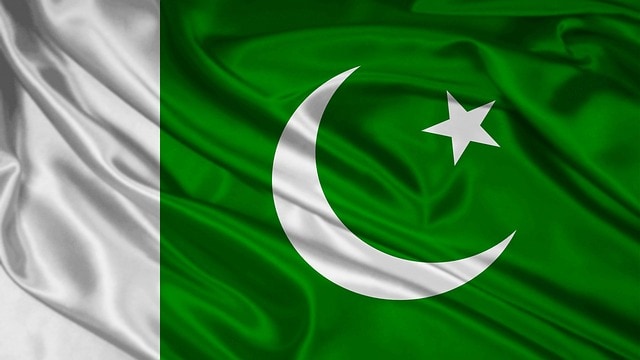
Most people today recognize the Star and Crescent symbol as the official symbol of Islam. While that’s not necessarily the case according to all religious leaders, the majority of Muslim followers do revere this symbol as a holy representation of their religious faith. So much so that you can now find the Star and Crescent symbol over most Muslim mosques and even on the flags of some Islamic countries such as Pakistan, Turkey, Libya, Tunisia, and Algeria.
A Case of Cultural Diffusion
As for how the symbol originated – it wasn’t an Islamic symbol at all. In fact, historians view this sign as a “case of cultural diffusion”, i. e. an interchange of cultural symbols, ideas, styles, etc. between different cultures. In the case of the Star and Crescent symbol, the symbol originated in the Ottoman Empire, the predecessor of modern-day Turkey. The Star and Crescent was the symbol of the Ottoman Turks.
While Turkey is predominantly Muslim today, that wasn’t always the case. When the Ottoman Turks conquered the Middle East, Northern Africa, and much of Eastern Europe, they didn’t initially follow Islam. To them, this was a foreign religion. They did adopt it over time from the Islamic states they had conquered, however, and, as a part of the “cultural diffusion”, Islam adopted the Star and Crescent symbol.
In fact, supporters of the use of the Star and Crescent symbol as an Islamic symbol have even found certain passages in the Quran which can be interpreted as supporting the use of the symbol even though the Quran was written long before the formation of the Ottoman Empire.
True Origin of the Star and Crescent
As for the true Ottoman origin of the Star and Crescent sign and its meaning – that is not entirely clear. Some historians speculate that the Ottoman Turks adopted it after conquering Constantinople, as the Crescent Moon was a common Byzantian symbol. However, as Constantinople followed the Christian faith, many Islamic historians reject this idea.
Instead, the leading theory among most Islamic scholars is the fact that various iterations of the Crescent symbol have been used in the Middle East for millennia, going as far back as the formation of the Parthian Empire. As the East Roman Empire (now known as Byzantium) had conquered most of the Middle East for quite some time, it’s entirely possible that they took the Crescent Moon symbol from there first.
2. Rub el Hizb

The Rub el Hizb symbol is another one that’s often viewed as a direct representation of the Muslim faith. It’s comprised of two overlapping squares – one placed parallel to the ground and one tilted at 45 degrees. Together, the two form an 8-pointed star. The last part of the symbol is a small circle drawn in the center of the star.
The meaning of the Rub el Hizb symbol is that it marks the endings of passages in the Quran. The “Rub” part of the symbol means quarter or one-fourth while “Hizb” means a party or a group. The logic behind this is that the Quran is divided into 60 equally long portions, or Hizbs, and each Hizb is further divided into four Rubs.
So, the Rub el Hizb marks all these divides and is frequently seen in the Quran. In fact, just like the Star and Crescent symbol, you can see the Rub el Hizb symbol on flags or emblems, including those in Morocco, Uzbekistan, and Turkmenistan.
3. The Color Green
The first important symbol we should mention isn’t an actual geometric symbol – it’s a color. Since its earliest days, the color green has been associated with Islam by most of its followers because of a particular line in the Quran (18:31) which states that “those who inhabit paradise will wear fine silk garments of green”.
And while, just like the other Abrahamic religions, Muslim scholars often maintain that many lines of their holy text are to be interpreted metaphorically or as allegories, this line is nevertheless viewed literally.
As a result of that, most Quran copies are covered with green bindings. Mosques are decorated in various colors but almost always with predominant green tones, and Sufi saints’ graves are covered with green silk. You may also notice that the flags of almost all Islamic countries include the color green in very prominent positions.
4. The Colors White and Black
The other two colors with powerful symbolism in Islam are white and black. As in other cultures, white is the color of purity and peace which is a key tenant in Islam. Black, on the other hand, has a very different symbolism in Islam than it does in other cultures. Here, black symbolizes modesty.
Together with green, white and black are also commonly featured in the flags of most predominantly Muslim countries. Red is also a commonly used color but it doesn’t seem to have a particularly key significance in Islam.
5. Allah
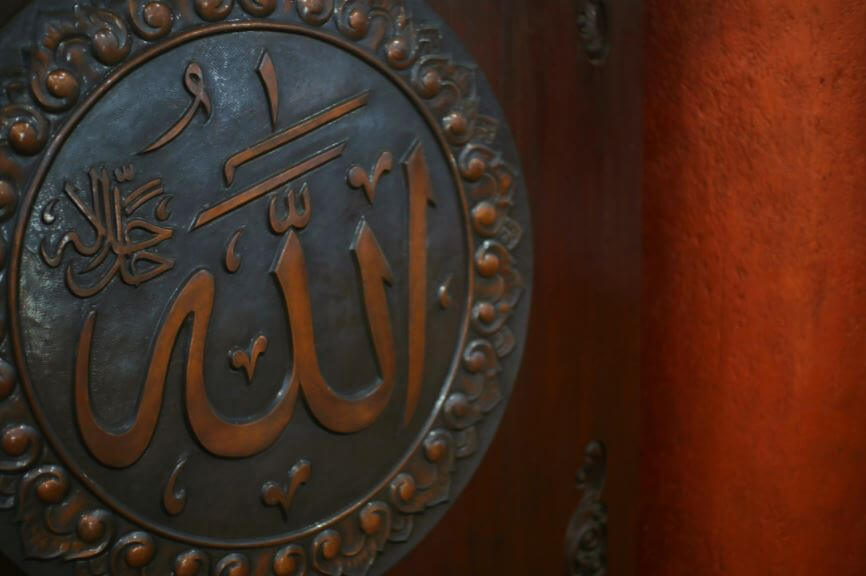
The Allah symbol is represented by the Arabic calligraphy for the word God (i.e. Allah). This is similar to Christianity where God isn’t technically given a name and is just called “God”. In that sense, the Allah symbol predates Islam as many Arabic peoples used it for the faiths they held before adopting the Muslim faith.
However, this doesn’t take away from the meaning of the Allah symbol in modern-day Islam. In Islam, Allah is the absolute, ever-present, and omnipotent Creator of the Universe. Devout Muslims live in complete submission to His will and in humble compliance with His commandments.
6. Shahada
The Shahada, or Shahadah, symbol is an old Islamic oath written in calligraphy. It’s one of the Five Pillars of Islam and it reads “I bear witness that none deserves worship except God, and I bear witness that Muhammad is the messenger of God”.
This whole phrase is comprised of multiple calligraphy symbols but is usually viewed as a single symbol as well since it’s written in a complex and beautiful circle.
7. Kaaba Mecca
Kaaba Mecca literally means Cube in Mecca and it is exactly that – a 3D building in the shape of a cube, with silk and cotton veils painted on the side. The Kaaba is in Mecca, and with Saudi Arabia being the holiest shrine in all of Islam, the Kaaba Mecca symbol is incredibly important to Muslims around the world.
The Kaaba is built at the center of Islam’s most important mosque – the Great Mosque of Mecca, also known as the House of God. No matter where in the world a Muslim lives, all their prayers must always be said facing Mecca. Additionally, every Muslim must make a pilgrimage (Hajj) to Mecca at least once in their lifetime – this is another one of the Five Pillars of Islam.
8. Hamsa Hand
The Hamsa Hand symbol in Islamic culture is closely connected to the Prophet Muhammad. It’s also sometimes called The Hand of Fatima, Fatima being the daughter of the Prophet Muhammad.
The symbol is easy to distinguish – it represents a human palm with three raised fingers – the index, middle, and ring finger – and folded pinky and thumb. In the middle of the palm, there is a human eye without an iris. The Hamsa Hand symbolizes defense, bravery, and power, and it’s often used as an icon of protection.
The reason Hamsa Hand is the more common term, as opposed to Hand of Fatima, is that Hamsa means five in Arabic, referring to the five fingers of the hand.
9. Cross of Agadez
Also called The Muslim Cross, the Cross of Agadez, this symbol is used only by the Sunni Muslim Tuareg people of Saharan Africa. It features a small cross at the center of a larger symbol and is viewed as a representation of Allah. The four stylized arms are viewed as the protective arms of God that will keep evil at bay.
The cross is often used as a protective amulet that the Sunni people wear in their day-to-day life. While the Cross of Agadez is a local symbol that isn’t recognized by other Islamic states, it’s crucial to the Sunni Tuareg people and it goes to show how diverse and multi-cultural the Islamic tradition is.
10. Khatim
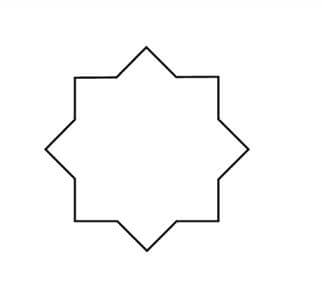
Drawn exactly like the Rub el Hizb, but without the small circle within the two squares, the Khatim symbol is known as the seal of the Prophet Muhammad. The term is generally interpreted to affirm the status of the Prophet Muhammad as the last real prophet of Islam and that there will be no other true prophet after him. This “finality” of Islam is a cornerstone to the Muslim faith and is also a part of the Shahada.
11. Bahai Star
The Bahai Star symbol is clean and simple in its design, and is drawn as a 9-pointed star. This symbol is closely related to the sacred number 9 and its main symbolism is related to God’s messengers or prophets. It teaches that the lessons of Allah are given to us slowly and progressively through his various messengers and prophets such as Jesus and Muhammed.
12. Halal
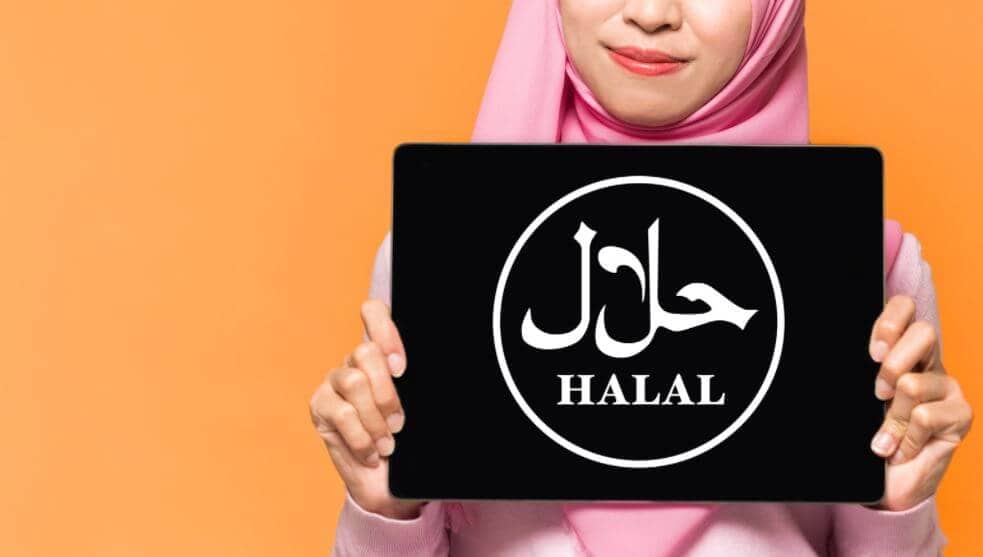
The symbol for Halal consists of the Arabic calligraphy of the word which directly translates as permissible or lawful. As such, Halal symbolizes things that are permissible by Allah and in the Muslim faith. Its opposite is Haram, which translates as unlawful.
However, the most common use for the Halal word and symbol is in relation to dietary permissions, especially when it comes to meat. It’s used to indicate which meats are allowed for consumption and which (such as pork) aren’t.
Today, Halal is also often used in relation to various cosmetic and pharmaceutical products which often contain animal by-products.
Wrapping Up
Although Islam doesn’t put much stock into iconography and symbols, there are still many that remain meaningful to its followers. If you’re interested in learning about other religious symbols, check out our collection that covers everything from Hinduism and Jainism to Christianity and Buddhism, as well as other lesser known religions and mythologies like the Yoruba beliefs.








